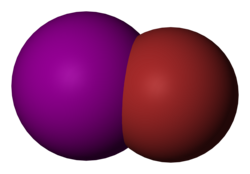 | |
 | |
 | |
| Names | |
|---|---|
| IUPAC name Iodine monobromide | |
| Other names Iodine bromide | |
| Identifiers | |
3D model (JSmol) | |
| ChemSpider | |
| ECHA InfoCard | 100.029.236 |
PubChem CID | |
| UNII | |
CompTox Dashboard (EPA) | |
| |
| |
| Properties | |
| IBr | |
| Molar mass | 206.904 g/mol |
| Appearance | dark red solid |
| Melting point | 42 °C (108 °F; 315 K) |
| Boiling point | 116 °C (241 °F; 389 K) |
| Related compounds | |
Other anions | iodine monochloride, iodine monofluoride |
Related interhalogen compounds | Iodine monochloride Iodine monofluoride Bromine monochloride |
Except where otherwise noted, data are given for materials in their standard state (at 25 °C [77 °F], 100 kPa). | |
Iodine monobromide is an interhalogen compound with the formula IBr. It is a dark red solid that melts near room temperature. [1] Like iodine monochloride, IBr is used in some types of iodometry. It serves as a source of I+. Its Lewis acid properties are compared with those of ICl and I2 in the ECW model. It can form CT adducts with Lewis donors. [2]
Iodine monobromide is formed when iodine and bromine are combined in a chemical reaction:. [3]
- I2 + Br2 → 2 IBr